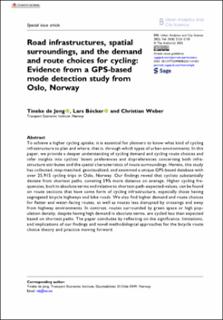| dc.contributor.author | de Jong, Tineke | |
| dc.contributor.author | Böcker, Lars | |
| dc.contributor.author | Weber, Christian | |
| dc.coverage.spatial | Norway, Oslo | en_US |
| dc.date.accessioned | 2024-01-17T15:55:00Z | |
| dc.date.available | 2024-01-17T15:55:00Z | |
| dc.date.created | 2023-01-03T13:37:14Z | |
| dc.date.issued | 2022-11-28 | |
| dc.identifier.citation | Environment and planning. B: Urban analytics and city science. 2023, 50 (8). | en_US |
| dc.identifier.issn | 2399-8083 | |
| dc.identifier.uri | https://hdl.handle.net/11250/3112302 | |
| dc.description | This article is distributed under the terms of the Creative Commons Attribution-NonCommercial 4.0 License (https://creativecommons.org/licenses/by-nc/4.0/) which permits non-commercial use, reproduction and distribution of the work without further permission provided the original work is attributed as specified on the SAGE and Open Access page (https://us.sagepub.com/en-us/nam/open-access-at-sage).
Request permissions for this article. | en_US |
| dc.description.abstract | To achieve a higher cycling uptake, it is essential for planners to know what kind of cycling infrastructure to plan and where, that is, through which types of urban environments. In this paper, we provide a deeper understanding of cycling demand and cycling route choices and infer insights into cyclists’ latent preferences and dispreferences concerning both infrastructure attributes and the spatial characteristics of route surroundings. Hereto, this study has collected, map-matched, geovisualized, and examined a unique GPS-based database with over 25,915 cycling trips in Oslo, Norway. Our findings reveal that cyclists substantially deviate from shortest paths, covering 59% more distance on average. Higher cycling frequencies, both in absolute terms and relative to shortest-path-expected-values, can be found on route sections that have some form of cycling infrastructure, especially those having segregated bicycle highways and bike roads. We also find higher demand and route choices for flatter and water-facing routes, as well as routes less disrupted by crossings and away from highway environments. In contrast, routes surrounded by green space or high population density, despite having high demand in absolute terms, are cycled less than expected based on shortest paths. The paper concludes by reflecting on the significance, limitations, and implications of our findings and novel methodological approaches for the bicycle route choice theory and practice moving forward. | en_US |
| dc.language.iso | eng | en_US |
| dc.publisher | SAGE Publications | en_US |
| dc.rights | Attribution-NonCommercial 4.0 Internasjonal | * |
| dc.rights.uri | http://creativecommons.org/licenses/by-nc/4.0/deed.no | * |
| dc.subject | Cycling | en_US |
| dc.subject | route choice | en_US |
| dc.subject | infrastructure | en_US |
| dc.subject | land use and planning | en_US |
| dc.subject | GIS | en_US |
| dc.subject | Oslo Norway | en_US |
| dc.title | Road infrastructures, spatial surroundings, and the demand and route choices for cycling: Evidence from a GPS-based mode detection study from Oslo, Norway | en_US |
| dc.title.alternative | Road infrastructures, spatial surroundings, and the demand and route choices for cycling: Evidence from a GPS-based mode detection study from Oslo, Norway | en_US |
| dc.type | Journal article | en_US |
| dc.type | Peer reviewed | en_US |
| dc.rights.holder | © The Author(s) 2022 | en_US |
| dc.description.version | publishedVersion | en_US |
| cristin.ispublished | true | |
| cristin.fulltext | preprint | |
| cristin.qualitycode | 2 | |
| dc.identifier.doi | 10.1177/23998083221141431 | |
| dc.identifier.cristin | 2099710 | |
| dc.source.journal | Environment and planning. B: Urban analytics and city science | en_US |
| dc.source.volume | 50 | en_US |
| dc.source.issue | 8 | en_US |
| dc.source.pagenumber | 18 | en_US |
| dc.relation.project | Norges forskningsråd: 255628 | en_US |

